MXA RACE TEST! THE REAL TEST OF THE 2024 KAWASAKI KX450
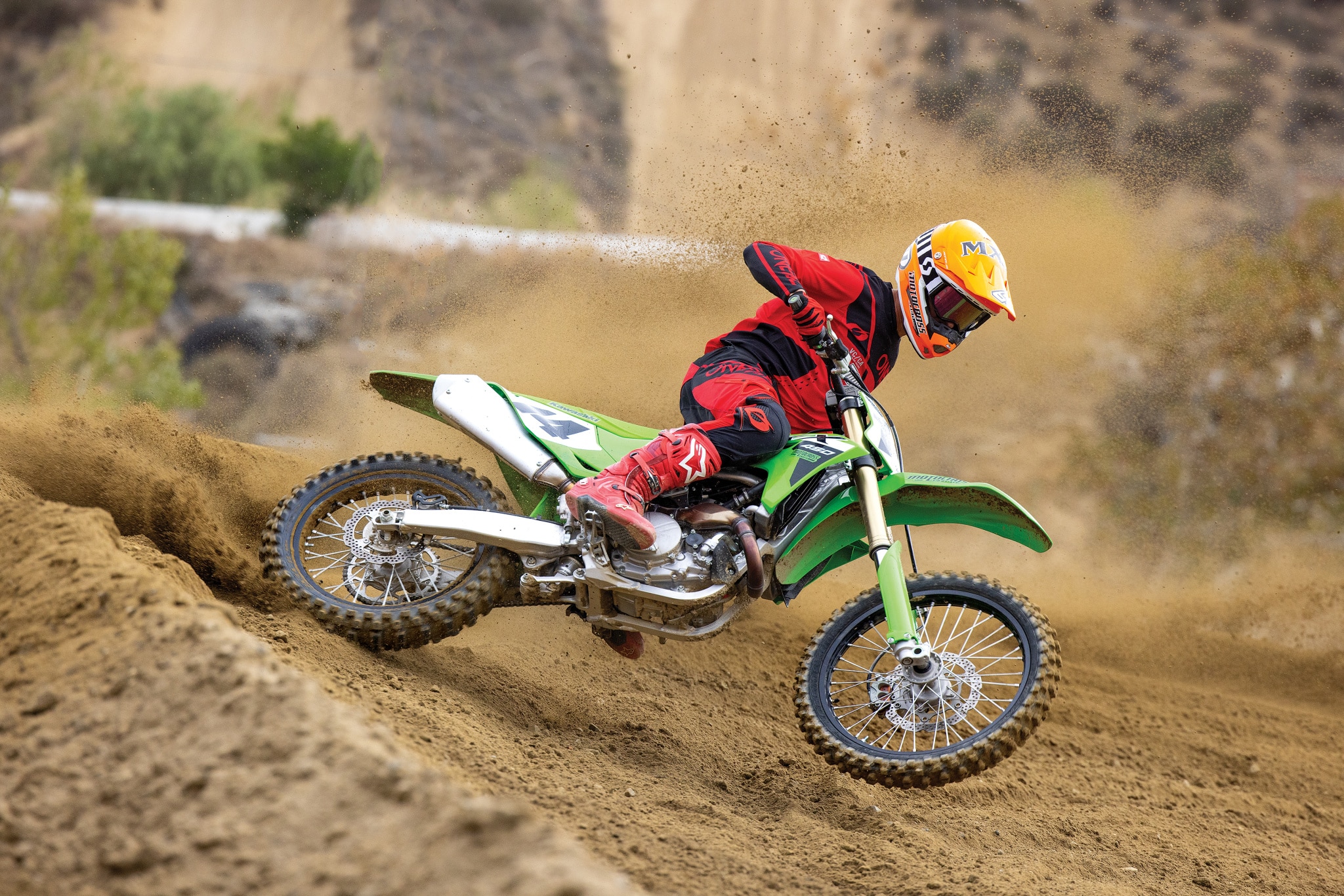
Q: FIRST AND FOREMOST, IS THE 2024 KX450 BETTER THAN THE 2023 KX450?
A: Yes, but with a few caveats. MXA is happy to see Kawasaki spend R&D money on an all-new frame, all-new engine, all-new bodywork, all-new electronics and all-new front brake (for them), but there are valid concerns about the 2024 KX450 being a “first-year model” since there is always a chance of some unresolved bugs, quirks and gremlins being exposed as the year progresses.
Q: WHAT’S NEW ON THE ENGINE?
A: The cylinder head houses a new center-port exhaust, which required a new frame to allow the exhaust pipe to exit straight forward. Additionally, the center port design enabled the intake tract, intake valves, exhaust valves and throttle body to align themselves in a straight run from the down-draft intake routing to the combustion chamber. The previous 2023 side-port cylinder head was not as efficient at delivering linear flow to the finger-follower valve train. The 2024 intake camshaft was raised 7mm to make room for the straight-line intake tract. On a side note, Kawasaki’s engineers also long-rodded the engine by making the connecting rod 5mm longer, which doesn’t change the bore and stroke, but does lessen side thrust loads on the cylinder wall.
As a final touch, the center-port exhaust pipe is tucked in tighter to the frame as it curves rearward, while the pipe’s resonance chamber was flattened to move it 54mm inward (eliminating the need for a heat shield). The muffler was moved 85mm (3.3 inches) forward, while the muffler’s canister was tapered from large to small for better packaging
Q: WHAT’S NEW ON THE FRAME?
A: There were two types of modifications done to the 2024 KX450 frame: (1) Changes made to accommodate the center-port engine, downdraft intake system and redesigned airbox. (2) Changes to bring the 2024 KX450’s frame geometry and layout up to date with modern design trends. Most notably, the head angle was changed from 27.6 degrees to 26.6 degrees for sharper cornering. Additionally, trail was decreased from 4.8 inches to 4.5 inches, and the rear shock tower was moved downward (to allow the air boot to go over the top of the shock tower a la Honda, so it could line up with the steep downward angle to get air to the 44mm throttle body). To facilitate this, the Showa shock was shortened 32mm while still maintaining the same stroke (although the piggyback reservoir had to be moved from the right side of the bike to the left side to make more room for the exhaust’s mid-pipe to pass through).
In a new twist, the frame has a four-hole bracket on both sides of the frame to allow the stock headstays to be replaced by an optional softer headstays to improve rear-wheel bite.
Q: WHAT’S NEW ON THE AIRBOX?
A: We used to think that the Yamaha YZ450F airbox design was the worst in the sport, but there is a new champion in that category. What were the Kawasaki engineers thinking when they designed this airbox? It has a litany of flaws and one mystery part. First, the volume of the airbox itself is incredibly tiny, made worse by the fact that it shares the space with the battery tray, battery and rectifier. Second, the air filter unit itself is a flat piece of foam held in place by a slide-in tray that looks like a license plate holder. It is nice that it doesn’t require any tools to get to or remove the air filter. Third, the actual surface air of the filter is so minuscule in comparison to most domed air filters that it gets dirty in half the time. Fourth, when we first started testing the 2024 KX450, it was so slow that we often had to downshift to first gear to get out of tight corners and were forced to clutch the engine to get it to pull third gear. It was much slower than the 2023 Kawasaki KX450 and lacked throttle response.
We were mystified until a Kawasaki technician told us that we should try the 2024 KX450 without the rubber plug in place. We hadn’t seen a rubber plug. The engineers hadn’t mentioned a rubber plug, and the spec sheet lacked any reference to a rubber plug. But, sure enough, once we removed the seat, the battery terminals, the battery and the battery tray, we saw it. It was an elongated 4.5-inch by 2.5-inch slab of rubber that blocked off a hole in the airbox.
During testing, we would send test riders out with the plug installed and then take the plug out so they could feel the difference. Two things of note: (1) The easiest way to get the rubber plug out is to take off the airbox cover, remove the air filter, reach up into the airbox, grab the rubber lip of the plug and pull it out. (2) If for some reason you want to put the rubber plug back in, set aside a reasonable block of time to wiggle the plug into place (after you remove the seat and battery).
Why is the rubber plug there? We surmise that during late pre-pro testing the Kawasaki test riders realized that the 2024 KX450 wasn’t getting enough air to run properly, but rather than mold an all-new airbox with proper air vents, they cut a hole and filled it with a plug. It is also possible that Kawasaki is gearing up for the new sound limits on the horizon.
Q: WHAT’S NEW ON THE SUSPENSION?
A: The workhorse 49mm Showa coil-spring forks used on the KX450, RM-Z450 and CRF450 have never reached their full potential, but for 2024, Kawasaki has come the closest to spec’ing valving and internal changes that allow the forks to roll off the assembly line ready to race. Okay, maybe not by fast Intermediates or Pros, but certainly by Kawasaki’s target audience of Vets and Novices. Visually, the only major change is that the trick-looking DLC coating on the fork tubes is gone, replaced by a downsized internal free-piston that reduces the stiction (which the DLC coating was supposed to do). With a claimed 80 percent reduction in the friction coefficient, thanks in large part to an improved O-ring material, the expensive coating is not necessary. But, when friction is reduced, so is damping, which is why the KX450’s Showa forks lean towards the soft side and feel pitchy in the bumps. Don’t be afraid to dial in more compression damping.
On the rear suspension, Kawasaki revised the rising-rate linkage to work in conjunction with the shorter shock and new frame geometry. Additionally, Showa honed the inner diameter of the shock body to ensure accurate roundness and less friction. Kawasaki claims that the honing process reduced shock stiction by 25 percent.
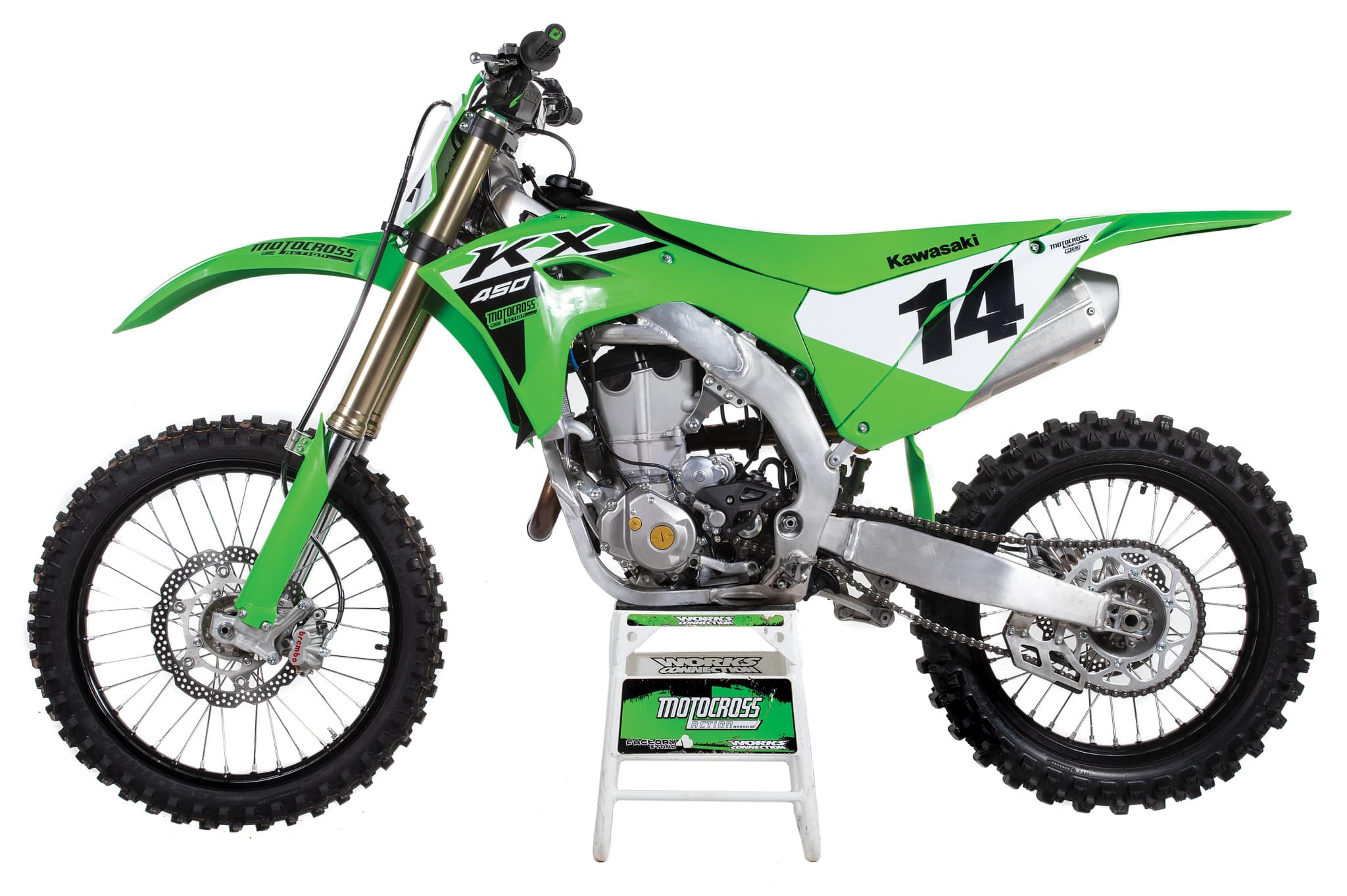
Q: WHAT’S NEW ON THE ELECTRONIC FRONT?
A: Every modern motocross bike has its own electronic peccadilloes. Here are the things we watch on the 2024 Kawasaki KX450.
(1) Kawasaki’s Rideology app. There is a communication module mounted to the left rear frame rail that allows a KX450 owner to connect wirelessly to the Kawasaki Rideology app from his smartphone. Once connected, the rider can make his own fuel and ignition maps using Kawasaki’s six-by-six grid.
So, what is the mystery? If you design your own map and put it in the “light on” spot on your map switch, the computer will detune your map by 15 percent; however, if you overwrite the stock map (light off), you will get your new map, but you will lose the stock map. We assume this automatic detuning feature is installed to keep backyard engineers from building maps that could over-rev the engine.
(2) Launch Control. The KX450’s Launch Control button retards the ignition timing above 7000 rpm to knock off as much as 4 horsepower, which helps riders maximize traction off the gate. Launch Control is activated by pressing the Power Mode button (M) and Traction Control button (T) simultaneously. A purple light indicates that Launch Control is engaged. It stays engaged until you shift to third gear.
(3) Traction Control. The Traction Control button (T) allows the rider to choose between low and high levels of traction control. It works by retarding the ignition when the ECU recognizes runaway revs (as when the rear wheel spins). Low Traction Control displays a solid green light, while high Traction Control is a blinking green light
Q: HOW DOES THE 2024 KAWASAKI KX450 RUN ON THE TRACK?
A: We aren’t going to waste any time telling you how it runs with the rubber plug in place, because once we were done having every MXA test rider spin laps with the plug in place, we never reinstalled it—and you shouldn’t, either (because it is extremely difficult).
Before we threw a leg over the 2024 Kawasaki KX450, Kawasaki’s representatives went to great lengths to inform the MXA test riders that they were not chasing peak horsepower in 2024 but broader, easier-to-use power that suited the majority of 450 riders. In truth, that is the exact type of power that GasGas, Honda, KTM, Suzuki and Husqvarna already have in 2024—and, paradoxically, the same kind of power that the KX450 had from 2019 to 2023.
We deduced that Kawasaki was aiming its comments at the 2023–2024 Yamaha YZ450F, which isn’t actually a peak-horsepower contender (ranking fourth out of seven on peak power at 58.5 horsepower, while the KX450, with the rubber plug removed, ranks fifth at 58.27 horsepower). But, the YZ450F’s power is very aggressive, wheelie prone and quasar fast at high rpm.
We wish that Kawasaki had pursued peak horsepower and increased torque a little more aggressively because they could make much more top-end power without losing that broad, easy-to-use power they said they were aiming for. The classic example of that is the 2024 Husqvarna FC450. It delivers a nice, pleasant, brisk, non-confrontational Vet-style power, but peaks at a class-leading 61.18 horsepower.
We also put a 51-tooth rear sprocket on to help the KX450 pick up quicker in third gear, had Twixted Development make us a special map, replaced the choke dup stock exhaust pipe with a Pro Circuit Ti-6, added a Twin Air Power Flow airbox and domed air filter, drill holes in the airbox cover.
More power would help the 2024 KX450 immensely. KX450 owners can find that power in the aftermarket, but wouldn’t it be nice if they didn’t have to?
Q: HOW DOES THE 2024 KAWASAKI KX450 HANDLE?
A: Face it, Kawasaki finally went all in on designing a new chassis. Forget about the stable, upright handling style of the 2019 to 2023 models, because for 2024 Kawasaki mated aggressive turn-in with acceptable high-speed stability. We know from experience that getting sharp cornering without losing straight-line stability is a challenge.
For 2024, the Kawasaki KX450 turns light years better than it has in the past; however, it does want to over-steer into corners if the rider gets sloppy and, by the same token, it also suffers from serious head shake at speed. Oversteer and head shake are not traits that defined previous KX450s, but when you steepen the head angle by a full degree, you give to get. Both of these negative traits are fixable with careful chassis setup and, if Kawasaki wants to sell bikes to today’s audience, they need a bike that knifes through tight turns. Kawasaki is giving their customers what they want, handling-wise.
What are those chassis mods?
(1) Slide the forks down in the triple clamps until the fork caps are flush with the top of the triple clamp. This will improve stability and cut down on head shake at speed. Surprisinngly, not having much effect on turn-pin.
(2) Add a link to the chain and move the rear wheel as far back as it can go. This will calm the KX450 down in the rough stuff.
(3) We added a full-coverage skid plate, but unfortunately after our ignition cover got nicked and oil weeped out continously.
Q: WHAT DID WE HATE?
A: The hate list:
(1) Power. People who don’t race always say, “No one can use all the power that a 450cc motocross bike puts out.” Obviously, they have never tried to get a good start. Every rider, by the time he is halfway to the first turn, wishes his bike had 5 more horsepower. The same is true for climbing big hills, blasting down a deep sand straight or coming out of a corner side-by-side against a guy on a more powerful bike. The 2024 KX450 is at a disadvantage in all four of those situations.
(2) Airbox. Engines are nothing more than air pumps. They pump air into the combustion chamber and pump air out through the exhaust system. If delivered in the correct quantity, air is a thing of beauty. The 2024 KX450 airbox is not a thing of beauty.
(3) Air filter. The stock KX450 air filter looks like a piece of French toast. It doesn’t flow enough air and gets dirty very quickly.
(4) Rear-brake master cylinder. Where did Kawasaki find this ancient relic of a Nissan master cylinder? This is not the master cylinder that the KX450 has used over the last 20 years. The theory is that Kawasaki cast the frame to hold a Brembo rear-brake master cylinder, but then Kawasaki’s engineers changed their minds and decided to spec Nissin rear brakes and had to find a master cylinder that fit the Brembo bolt-hole spacing that was already cast into the frame.
(5) Weight. The 2024 Kawasaki KX450 weighs 239 pounds without gas in the tank. That is a 5-pound weight gain in a single year.
(6) Over-steer/head-shake. When an R&D department prioritizes accuracy at turn-in over everything else, they run the risk of over-steering in corners and head-shaking at speed. The best solution is to slide the forks down in the triple clamps until they are flush with the caps. That will stop head-shake and cut down on over-steer.
(7) Rubber plug. Is the rubber plug just a Band-Aid fix for the KX450 airbox, or does it serve some other purpose?
(8) Price. Be careful what you ask for. Last year MXA asked Kawasaki to make seven upgrades to the 2024 KX450. They did six of them and raised the MSRP of the KX450 to $10,399 from last year’s $9,599. That is an $800 price increase in one model year. We hate to think what the price would have been if we had gotten our seventh request.
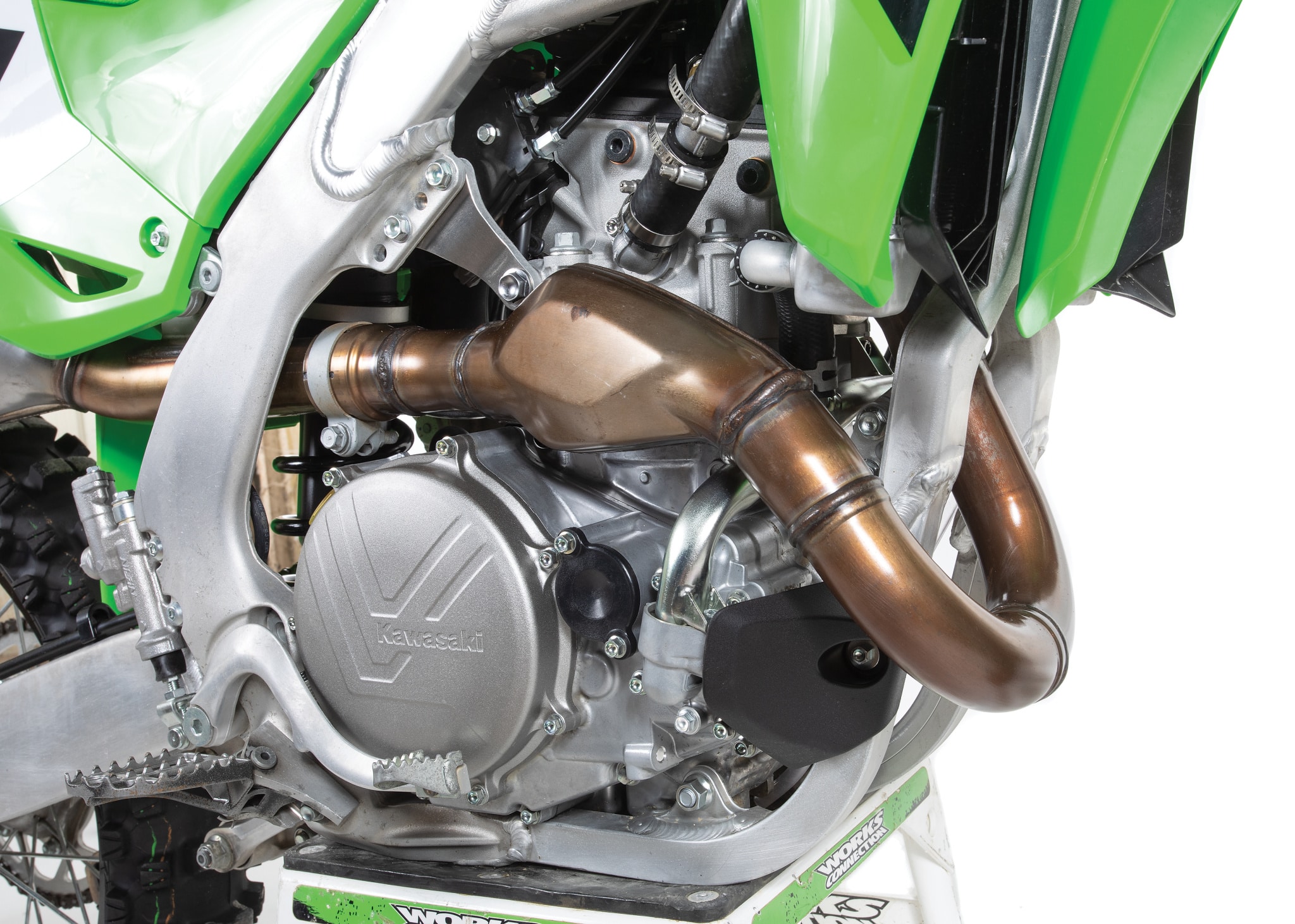
Q: WHAT DID WE LIKE?
A: The like list:
(1) Power Mode switch. Gone are the three plug-in couplers that KX450 riders used to have to swap out to change between the stock, mellow and aggressive maps. In their place is a Power Mode selector switch, which was obviously borrowed from Honda. It features a button that allows the rider to choose between two engine maps (stock and mellow), plus Traction Control and Launch Control.
(2) Brembo. The head engineer of the 2024 Kawasaki KX450 project must have fought an uphill battle trying to get Kawasaki Heavy Industries to buy Brembo brakes from Italy. But, it was the smart move to make. Great front brake.
(3) Bodywork. Kawasaki has never been known for sleek bodywork, well-chosen ergonomics or a seamless interface, but the new lime green plastic is a big step up in design.
(4) Handling. This is the first Kawasaki in recent memory that actually wants to turn.
(5) Footpegs. The KX450 footpegs can be moved down 5mm if you so desire. On the new chassis, the lower position felt better.
(6) Weight. The 2024 Kawasaki KX450 is the second-heaviest Japanese-made motocross bike after the Suzuki. The RM-Z450 weighs 241 pounds; the Kawasaki weighs 239 pounds.
(7) Bar mounts. The bars can be adjusted to four different locations. They come stock in the front holes with the bar mounts swiveled rearward, but most MXA test riders run the bar mounts in the rearward holes with the bars swiveled forward.
(8) Rear brake. No more jumbo-sized 250mm rear brake rotor, which means no more locking up the rear wheel. The new rotor is 240mm.
(9) Chain pad. The last of the disintegrating bottom chain rollers has been ash-canned. In its place is a KTM-style chain pad.
(10) Grips. Thankfully, Kawasaki has stopped vulcanizing its grips to the bars. The new ODI Lock-on grips make changing grips much easier.
(11) Rear hub. The new rear hub is now 58mm wide; it was 46mm wide. The wider span increases rear-wheel strength.
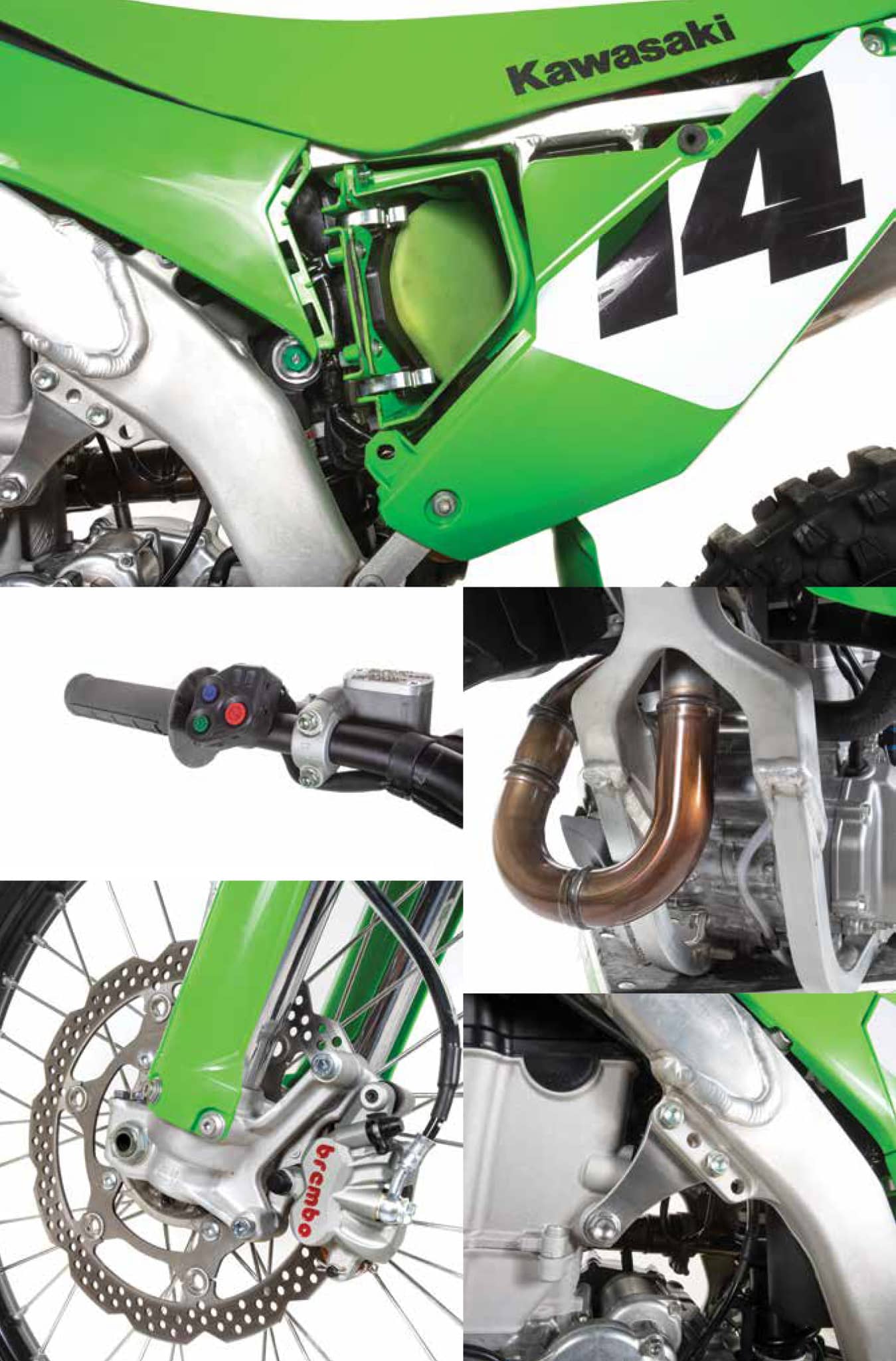
Q: WHAT DO WE REALLY THINK OF THE KAWASAKI KX450?
A: Last year we wrote that if the KX450 wanted to be the “2024 MXA 450 of the Year,” the KX450 needed seven things: (1) better forks, (2) a smaller rear rotor, (3) advanced electronics, (4) improved durability, (5) a stronger chain roller, (6) better plastic and (7) more actual horsepower. Kudos to Kawi. They gave us six out of the seven. But, that seventh one was a deal-breaker.



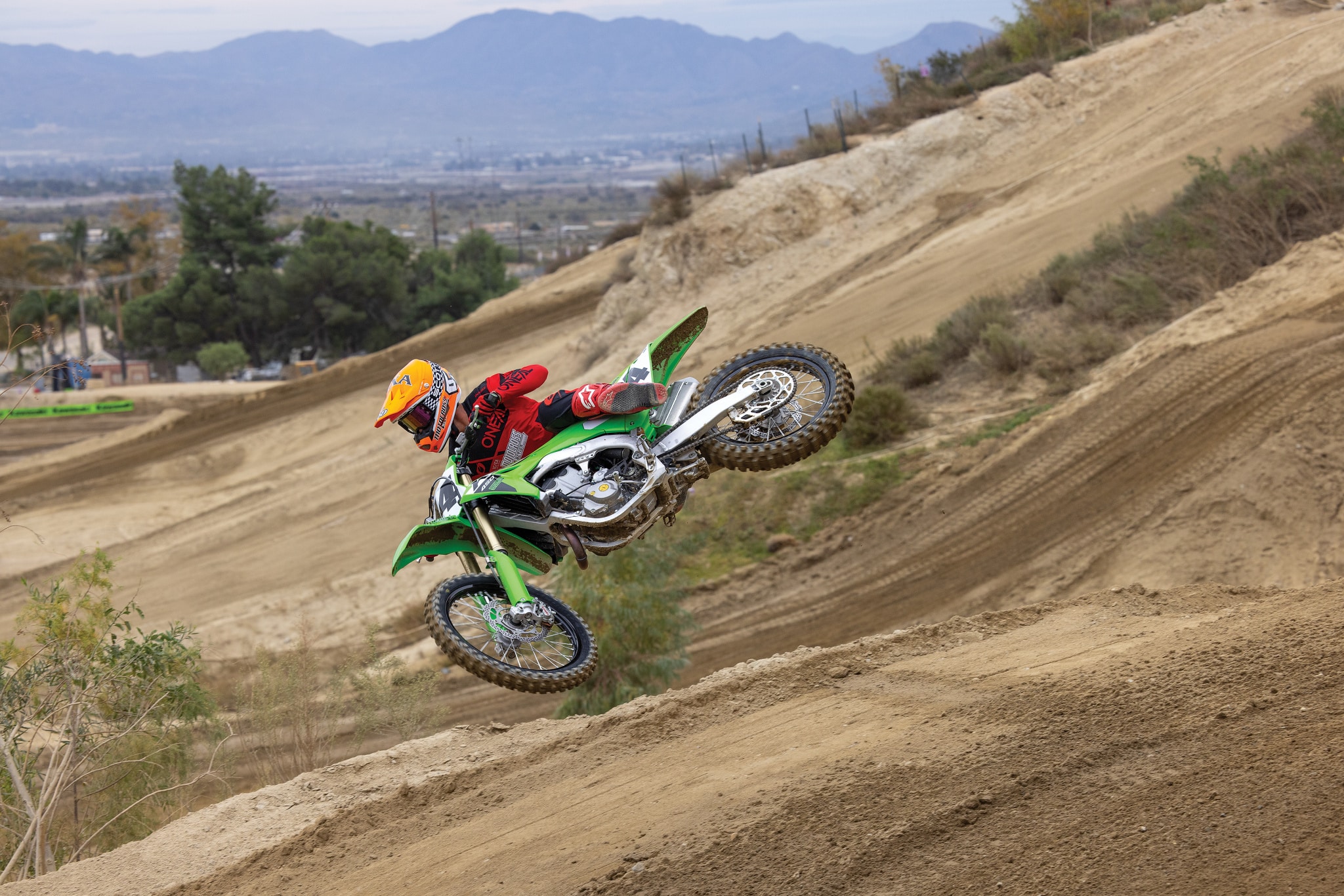
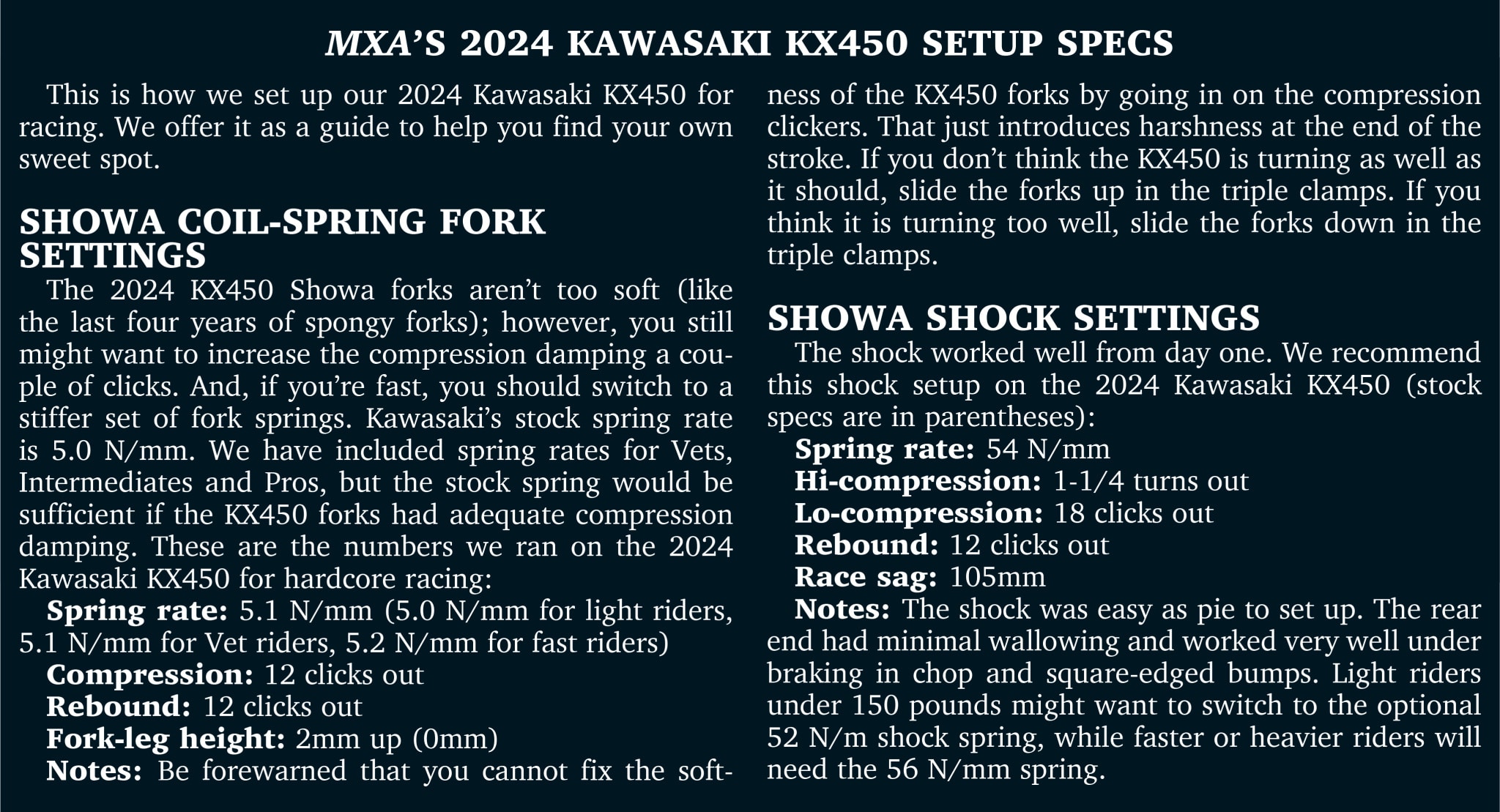




Comments are closed.